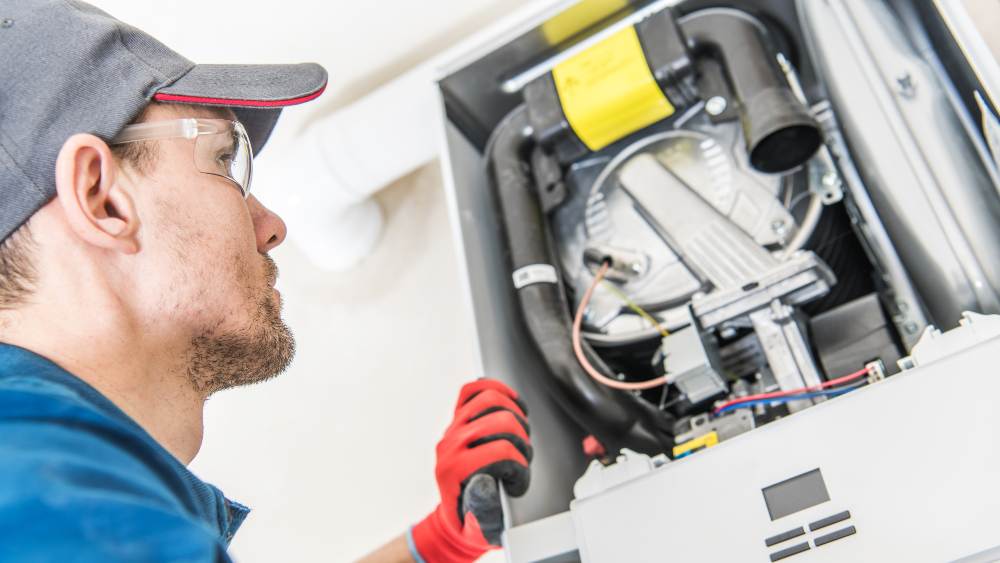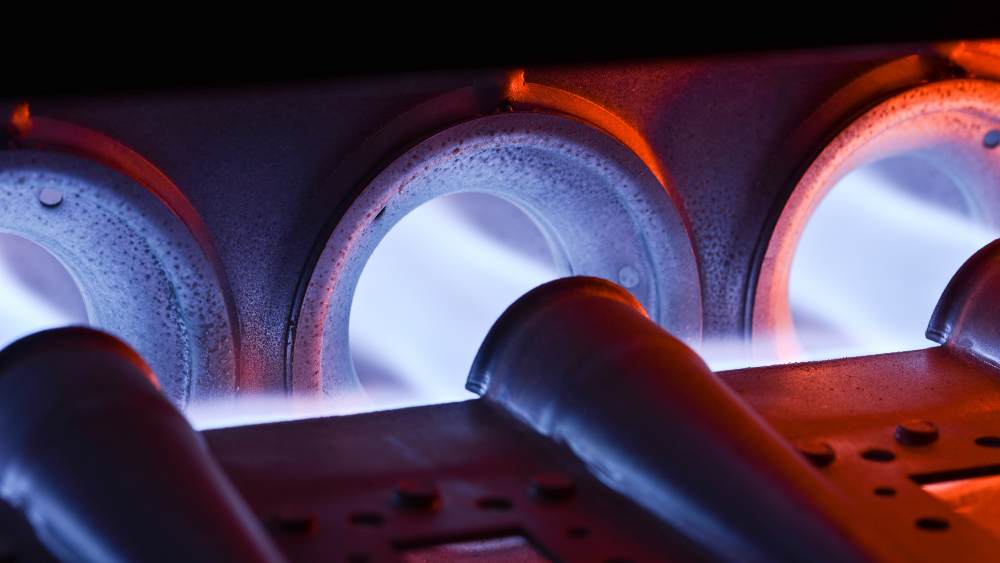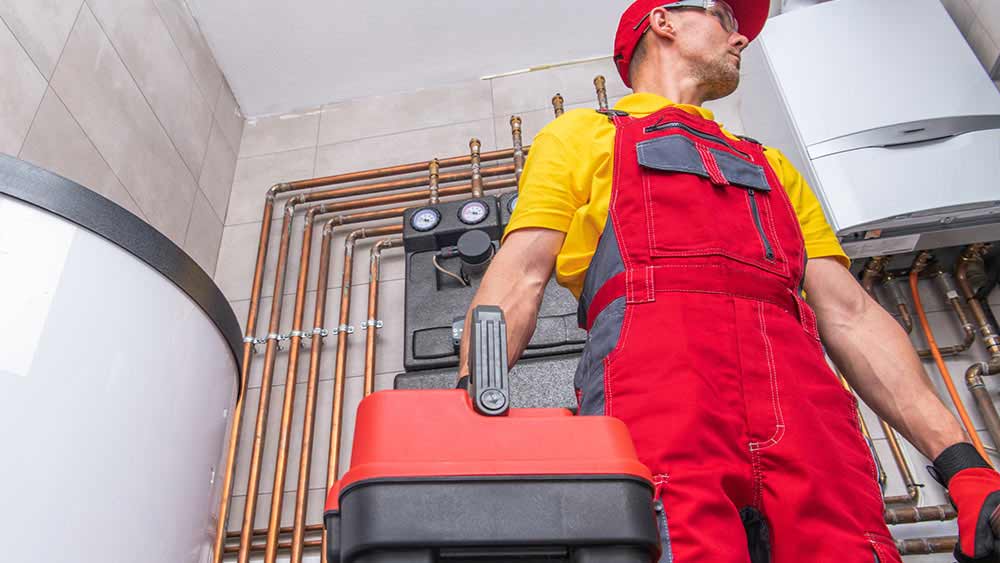
Key Takeaways
- Frequent breakdowns, high bills, uneven heating, signal it’s time for furnace replacement.
- The cost of furnace replacement depends on factors like efficiency, type, size, labor, and brand.
- Save on furnace replacement by comparing quotes and choosing high-efficiency models.
If your furnace is showing visible signs of aging, causing an uptick in your energy bills, or demanding frequent repairs, then it may be time for its replacement.
While furnaces are engineered for durability, several factors can impact their performance and lifespan. Over a decade or two, daily wear and tear can take its toll, and you will need to replace this central heating system.
On average, the cost to replace a furnace usually falls between the estimated range of $2,800 and $7,000. While it might seem quite a lot initially, the long-term benefits of investing in a high-efficiency model that lowers heating bills make it a worthwhile investment.
This blog will explore the key indicators that signal it’s time for a replacement and various factors that influence the costs of replacing a furnace. It will also share tips on how you can save money on replacement costs.
Signs You Require Furnace Replacement
If you suspect something is wrong with your furnace and it might require a replacement, look for the following signs:
1. Your Furnace Is 15+ Years Old
Well-maintained furnaces can last up to 15 years. Routine inspections and upkeep are crucial to ensuring optimal performance. However, even well-maintained furnaces need to be replaced after they have reached their typical lifespan.
2. Loud Noises During Standard Operation
Is your furnace making strange, alarming noises? Popping, rattling, screeching, humming, booming, or clicking sounds while your furnace is running could be signs of serious issues. It’s crucial to have a professional inspect your equipment, as these sounds might indicate problems with its parts. If the unusual noises persist even after repairs, it could be an indication that it’s time to consider replacing your furnace.
3. Temperature Fluctuations
If you are experiencing hot and cold spots in your home, then this is a sign that your furnace is struggling to distribute heat effectively.
When you notice inconsistent temperatures, with some areas of your home feeling excessively warm while others remain chilly, it suggests that your furnace is encountering difficulties in evenly distributing heat. If the problem persists even after addressing it through repairs, it may be an indication that replacement is necessary.
4. Furnace Flames Are Yellow Instead of Blue

The furnace pilot flame should burn blue and evenly. If you notice a yellow, irregular flame in your furnace, it could indicate a malfunctioning system, possibly due to dirty burners or a cracked heat exchanger. It’s crucial to contact a professional to investigate.
5. High Bills
If you’re experiencing a significant rise in your bills without any change in your furnace usage, it’s a clear indication of appliance deterioration.
Opting for new models with an impressive efficiency rate of 95-98% can help you reduce your heating bills.
6. Furnace Repairs Become More Frequent and Expensive
When your furnace starts breaking down frequently and requiring constant repairs, consider replacing it. Constant repairs can become expensive, and it may be more cost-effective in the long run to opt for equipment replacement.
How Much Does It Cost to Replace a Furnace?
Understanding the full cost of furnace replacement is essential. It goes beyond just the price of the new equipment.
On average, the cost of replacing a furnace is estimated at $4,757. However, the ultimate cost, considering both parts and labor, is subject to various factors, such as the type of furnace, the size of your residence, and considerations like efficiency and brand preferences. You also need to consider the fees for removing and disposing of your old furnace.
| Furnace Replacement Cost | |
| Average Cost | $4,757 |
| Highest Cost | $6,835 |
| Lowest Cost | $2,820 |
Main Factors Affecting Furnace Replacement Cost
Several factors can influence the cost of a new furnace installation, such as furnace type, brand, labor costs, etc.
-
Efficiency
The Annual Fuel Utilization Efficiency (AFUE) rating shows how well your heating unit can convert fuel into heat over a year. The higher the rating, the more efficient the unit is. So, if you’re looking for a high-efficiency furnace, aim for one with an AFUE rating of 90% to 98.5%.
High-efficiency furnace models feature a distinct design compared to other furnaces. In these models, fuel combustion occurs in a sealed chamber, minimizing heat loss. Although they may incur an initial upfront cost that is 50% to 100% higher than lower-efficiency models, the long-term utility bill savings make them a more cost-effective choice over time.
To calculate how much you will save on your heating bills by switching to a more efficient furnace, multiply the efficiency percentage by your current bill. For example, if you purchase a furnace that is 20% more efficient than your current unit, multiply 20% by the cost of your monthly bill to see your potential savings. You can also subtract the AFUE rating of your old furnace from the AFUE rating of your new furnace. For instance, if you transition from an 80% efficiency furnace to one with 95% efficiency, you can anticipate a 15% reduction in your bills.
-
Type
The cost of replacing a furnace varies depending on the fuel source. Electricity and natural gas are the most prevalent sources, followed by oil and propane.
- Gas Furnaces: The majority of residential furnaces in the United States utilize natural gas as a fuel source, offering a well-balanced combination of cost, efficiency, and power. The gas furnace replacement costs range from $3,800 to $10,000. They have a slightly higher upfront expense compared to electric furnaces. Still, they prove to be more efficient in the long run, especially if your home already has a gas line in place.
- Electric Furnaces: Electric furnaces are inexpensive to purchase, and replacing them can cost between $1,600 and $6,900. However, they use a lot of power to keep your house heated, resulting in high electricity bills. These heating units are also slow to heat and thus are more suitable for milder climates.
- Oil Furnaces: They exhibit moderate energy efficiency, typically boasting AFUE ratings between 80 and 90%. These furnaces have become less popular due to the increasing price of oil. Burning oil is less efficient as it wastes some heat as exhaust, and it tends to produce a significant amount of soot. However, oil furnaces are still found in homes in the northeastern United States, where harsh winters prevail. Some of these furnaces can be retrofitted to burn biodiesel or other renewable types of fuel, providing an environmentally friendly alternative. Oil furnace replacement costs range from $6,750 to $10,000.
- Propane Furnaces: Propane furnaces offer a great alternative to gas-powered furnaces in case your home doesn’t have a gas line. They have AFUE ratings spanning from 90% to 98.5%. The installation cost of propane furnaces typically falls within the range of $3,400 to $7,135. However, it’s important to note that an additional expense involves installing a propane tank if one is not already in place, which can range from $700 to $8,150.
Related: 12 Types of Heating Systems to Keep You Warm
-
Size
The size of a furnace is measured in British Thermal Units (BTUs). To determine the appropriate BTUs for your space, you can roughly calculate it by multiplying the square footage of the area you want to heat by 40. For example, a 2,300-square-foot home would require a furnace with a minimum of 92,000 BTUs. It’s recommended to factor in additional BTUs to ensure optimal heating efficiency in colder areas.
You can refer to this table to find out the average cost to replace your furnace by size.
| Furnace BTU | Sq. Ft. | Average Price Range |
| 30,000 – 60,000 | 750 – 1,500 | $1,500 – $3,000 |
| 60,000 – 90,000 | 1,500 – 2,250 | $3,000 – $4,500 |
| 90,000 – 120,000 | 2,250 – 3,000 | $4,500 – $6,000 |
-
Labor Costs
Furnace installers generally charge between $75 and $150 per hour, and the entire installation process typically takes 4 to 8 hours. By understanding and factoring in these labor costs, you will have a better grasp of the overall investment needed for your furnace replacement.
-
Installation vs. Replacement
The cost of replacing an old furnace is generally lower than installing a completely new one, especially when opting for a replacement of the same type and similar size. The existing infrastructure makes installation easier and more affordable. However, switching from one type of furnace to another requires extra work and increases expenses.
Switching to an electric furnace is a more cost-effective choice, as electric units don’t necessitate exhaust vents or gas inputs. Transitioning from a boiler to a gas furnace is a pricier endeavor, primarily because it involves a shift from a radiator system to a ducted system. If your home already has existing ductwork, the average cost is $4,200. However, if new air ducts need to be installed, the expense can increase substantially, reaching up to $17,000.
If you’re planning to move the furnace, the extent of the move also affects the overall cost. A small shift within the same room incurs minimal additional expenses. However, relocating the furnace to an entirely different floor involves more extensive work and higher installation costs.
-
Heating Stages
The choice of heating stages significantly influences the cost of a new furnace. Furnaces come with different heat stages: single, double, or modulating. In a single-stage heat system, the furnace operates in an on/off mode. With double-stage heat, the furnace initially turns on and then switches between higher and lower stages based on your heating requirements. In a modulating heat system, the furnace starts up and adjusts gradually, responding to the changing temperature needs.
Opting for a single-stage furnace is the most economical option. Transitioning to a two-stage furnace will result in an additional cost of a few hundred dollars.
-
Brand
Choosing a residential furnace involves considering various popular HVAC brands like Lennox, Trane, Carrier, and so on. Your decision impacts costs, with factors such as furnace type and local availability of the brand influencing the choice. Aligning specific furnace needs with regional market options is key to making an informed decision.
-
Tax Credits
Did you know that you can recoup some of the expenses from your new furnace through tax credits? Currently, both oil and gas furnaces qualify for a credit of 30%, up to $600.
However, tax laws are always changing, which is why it’s essential to consult with professionals before replacing your furnace.
-
Disposal of Old Furnace
When you hire furnace installers to replace an old unit, they often remove and dispose of the old furnace, which may be an extra charge on your bill.
To avoid unexpected costs, ask your contractor if the disposal fee is included in their quote. Being clear about these details will help you fully understand the financial aspects of the furnace replacement process.
-
Home Warranty
A home warranty covers the expenses associated with repairing or replacing appliances when they malfunction due to normal wear and tear. Heating systems, including furnaces, are typically included in the coverage.
If your furnace is approaching the end of its operational life but is still working properly, consider investing in a home warranty if you don’t have one already. This way, you can contact your provider whenever your furnace experiences an issue, and the company will dispatch one of its contractors to handle the necessary repairs. If the furnace cannot be repaired, the provider often covers the cost of a replacement. It’s crucial to familiarize yourself with the details of your home warranty so you can use it effectively when dealing with furnace problems.
-
Permits
Installing a new furnace, replacing an old one, or moving an existing unit often requires permits. When working with a licensed contractor, the cost of permits is typically included in the overall quote, and the contractor takes care of the permit process for you.
Make sure to ask contractors about the permit process and how you will be charged for it. By proactively addressing permit-related matters, you can ensure a hassle-free and compliant furnace installation.
DIY vs. Professional Furnace Replacement
Choosing between a professional and a DIY installation approach for furnace replacement is a critical decision. While some home improvement projects are manageable for homeowners, replacing a furnace is not one of them. Given the furnace’s vital role in maintaining home comfort, improper installation can jeopardize not only your system’s efficiency but also your safety.
Attempting a furnace replacement on your own is strongly discouraged unless you possess expertise as an HVAC technician. This type of project demands knowledge of HVAC systems, electrical work, precise metalwork, and plumbing.
Professional HVAC technicians go beyond simple furnace replacement. They ensure the proper connection and safe operation of the system. Before completing the job, technicians verify that the heating system functions correctly, does not release harmful gases, and is seamlessly integrated into the duct system. Additionally, professional installations often come with a workmanship warranty, covering the cost of furnace repairs in case of incorrect installation.
How to Lower Your Furnace Replacement Cost
Here are some tips to guide you in helping you cut down on your furnace replacement cost:
- You can save on furnace replacement costs by checking for rebates that the government provides for energy-efficient home appliances. This can help reduce the overall expense of purchasing a new furnace. Check your utility company’s website for more details on the incentive programs you can take advantage of.
- When buying a new furnace, take the time to gather quotes from numerous HVAC contractors. Evaluate the prices and services offered by these companies to ensure that you secure a reasonable deal.
- Purchasing a high-efficiency furnace will greatly reduce your heating bills. These furnaces may cost a lot initially, but their energy-saving features will ultimately reduce your overall cost. Furthermore, you can invest in a smart thermostat to manage your home’s energy consumption. This smart device offers various energy-saving features to help you cut down on your heating bills in the long run.
- During the installation process, you can take some preparatory tasks yourself, like clearing the installation space or disconnecting the old furnace. This can help you save on labor costs. Opting for off-season installation can also help save on technician fees, as lower demand may allow you to negotiate a more favorable price.
- Even if your furnace is currently situated in a less-than-ideal location, it’s best not to move it if you are looking to save on money. The expenses associated with relocating the furnace to a new spot are likely to exceed the costs of simply replacing it in its existing location.
Equip your HVAC system with smart features and achieve the perfect balance between comfort & savings.
Learn more
Prolong Your Furnace Life With Regular Maintenance

Ensuring optimal heating efficiency requires proper furnace maintenance. Whether your furnace is new or has been in your home for a while, performing routine maintenance tasks, such as furnace filter replacement, can significantly impact its performance and energy costs. Before embarking on a furnace cleaning project, it is crucial to cut off the electrical power and fuel supply. Equally important is having the necessary tools and spare parts readily available to ensure a successful job completion. If ever in doubt, it is advisable to seek assistance from a professional.
FAQs
Why Is Replacing a Furnace So Expensive?
The high cost associated with furnace replacement is primarily due to the need for skilled labor, who charge between $75 and $150 per hour. Additionally, furnaces themselves are expensive pieces of equipment, and replacing them can cost between $1,600 and $10,000; other considerations like brand, type of furnace, and energy efficiency also contribute to the overall expense of the replacement.
The furnace blower motor replacement is the most expensive; it can cost as much as $2,000. Moreover, replacing other crucial parts comes with significant expenses, such as up to $1,500 for a heat exchanger, $600 for a circuit board, and as much as $1,500 for a draft inducer motor.
What Is the Best Time of Year to Buy a Furnace?
The ideal time to get a new furnace is during the spring or summer. This is because the demand is low, meaning furnace installers can offer more competitive prices and flexible scheduling. Plus, getting your furnace installed before the cold season means you won’t have to worry about being stuck without heat in case any issue comes up during the installation process.
In Conclusion
Furnace replacement involves thoughtful consideration of several key factors. When replacing an old furnace, it’s tempting to stick with the same type of fuel, but upgrading to a high-efficiency model can bring about substantial savings on heating costs while also contributing to a reduced environmental impact. Understanding the sizing requirements for furnaces and selecting the right size for your home is crucial for optimal performance. Remember to always consult with a certified technician for replacement and keep up with routine maintenance to prolong the lifespan of your furnace.








